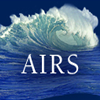
|
Jacob Davis Research Assistant jdavis@apl.washington.edu |
Videos
|
microSWIFTs: Tiny Oceanographic Floats Measure Extreme Coastal Conditions These small, inexpensive ocean drifters are the latest generation of the Surface Wave Instrument Float with Tracking (SWIFT) platform developed at APL-UW. They are being used in several collaborative research experiments to increase the density of nearshore wave observations. |
19 Apr 2022
|
|
Publications |
2000-present and while at APL-UW |
Multiscale measurements of hurricane waves using buoys and airborne radar Davis, J.R., J. Thomson, B.J. Butterworth, I.A. Houghton, C. Fairall, E.J. Thompson, and G. de Boer, "Multiscale measurements of hurricane waves using buoys and airborne radar," In Proc., IEEE/OES 13th Current, Waves and Turbulence Measurement (CWTM), 18-20 March 2024, Wanchese, NC, doi:10.1109/CWTM61020.2024.10526332 (IEEE, 2024). |
More Info |
15 May 2024 |
|||||||
|
The processes important to hurricane wave generation cover scales from kilometers to centimeters. Within a storm, waves have complex spatial variations that are sensitive to hurricane size, strength and speed. This makes it challenging to measure the spatial variability of hurricane waves with any single instrument. To obtain both broad spatial coverage and resolve the full range of wave scales, we combine arrays of drifting wave buoys with airborne radar altimetry. The microSWIFT (UW-APL) and Spotter (Sofar) buoys are air-deployed along a given storm track. These buoys resolve the scalar wave frequency spectrum from 0.05 Hz to 0.5 Hz, which is approximately 600 m to 6 m wavelength (in deep water). The Wide Swath Radar Altimeter (WSRA) flies into hurricanes aboard the NOAA Hurricane Hunter P-3 aircraft. The radar altimetry data is processed to produce a 2D directional spectrum from 2.5 km to 80 m wavelength, and the radar backscatter provides an estimate of the mean square slope down to centimeter wavelengths. We introduce a method to use colocated mean square slope observations from each instrument to infer the shape of the spectral tail from 0.5 Hz to almost 3 Hz. The method is able to recover the frequency f–5 tail characteristic of the saturation range expected at these frequencies (based on theory and measurements in lower wind speeds). We also explore the differences between WSRA and buoy mean square slopes, which represent the mean square slope of the intermediate wavelength waves (6 m down to 20 cm). Together, the fusion of these wave measurements provides a multiscale view of the hurricane-generated waves. These ocean surface waves are critical as drivers of the air-sea coupling that controls storm evolution and as drivers of coastal impacts by hurricanes. |
|||||||||
Development and testing of microSWIFT expendable wave buoys Thomson, J., P. Bush, V.C. Contreras, N. Clemett, J. Davis, A. de Klerk, E. Iseley, E.J. Rainville, B. Salmi, and J. Talbert, "Development and testing of microSWIFT expendable wave buoys," Coastal Eng. J., EOR, doi:10.1080/21664250.2023.2283325, 2023. |
More Info |
22 Nov 2023 |
|||||||
|
Expendable microSWIFT buoys have been developed and tested for measuring ocean surface waves. Wave spectra are calculated via onboard processing of GPS velocities sampled at 5 Hz, and wave spectra are delivered to a shore-side server via Iridium modem once per hour. The microSWIFTs support additional sensor payloads, in particular seawater conductivity and temperature. The buoys have a non-traditional, cylindrical shape that is required for deployment via the dropsonde tube of research aircraft. Multiple versions have been developed and tested, with design considerations that include: buoy hydrodynamics, sensor noise, algorithm tuning, processor power, and ease of deployment. Field testing in a range of conditions, including near sea ice and in a hurricane, has validated the design. |
|||||||||
Observations of ocean surface wave attenuation in sea ice using seafloor cables Smith, M.M., J. Thomson, M.G. Baker, R.E. Abbott, and J. Davis, "Observations of ocean surface wave attenuation in sea ice using seafloor cables," Geophys. Res. Lett., 50, doi:10.1029/2023GL105243, 2023. |
More Info |
28 Oct 2023 |
|||||||
|
The attenuation of ocean surface waves during seasonal ice cover is an important control on the evolution of Arctic coastlines. The spatial and temporal variations in this process have been challenging to resolve with conventional sampling using sparse arrays of moorings or buoys. We demonstrate a novel method for persistent observation of wave-ice interactions using distributed acoustic sensing (DAS) along existing seafloor fiber optic telecommunications cables. DAS measurements span a 36-km cross-shore cable on the Beaufort Shelf from Oliktok Point, Alaska. DAS optical sensing of fiber strain-rate provides a proxy for seafloor pressure, which we calibrate with wave buoy measurements during the ice-free season (August 2022). We apply this calibration during the ice formation season (November 2021) to obtain unprecedented resolution of variable wave attenuation rates in new, partial ice cover. The location and strength of wave attenuation serve as proxies for ice coverage and thickness, especially during rapidly evolving events. |
|||||||||
In The News
|
Why physicists are air-dropping buoys into the paths of hurricanes New Scientist, James Dinneen A sprawling research program aims to improve hurricane forecasts by collecting data at the chaotic interface of ocean and atmosphere. |
20 Sep 2024
|
|
UW scientists drop sensors into Hurricane Ian KING5 News, Sebastian Robertson The technology measures waves on the ocean's surface right beneath a hurricane. It's information researchers hope can one day improve weather forecasting. |
29 Sep 2022
|
|
UW-developed wave sensors deployed to improve hurricane forecasts UW News Jacob Davis, a UW doctoral student in civil and environmental engineering, and members of the U.S. Navy’s VXS-1 Squadron deployed wave sensing buoys in the path of Hurricane Ian, before the hurricane made landfall. |
28 Sep 2022
|






